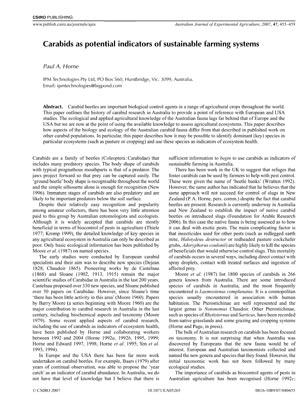|
|
Carabid beetles are important biological control agents in a range of agricultural crops throughout the world. This paper outlines the history of carabid research in Australia to provide a point of reference with European and USA studies. The ecological and applied agricultural knowledge of the Australian fauna lags far behind that of Europe and the USA but we are now at the point of using the available knowledge to assess agricultural ecosystems. This paper describes how aspects of the biology and ecology of the Australian carabid fauna differ from that described in published work on other carabid populations. In particular, this paper describes how it may be possible to identify dominant (key) species in particular ecosystems (such as pasture or cropping) and use these species as indicators of ecosystem health.
The current state of knowledge about Australian carabids suggests that this group of beetles is most likely to be used as indicators of ecosystem disturbance and sustainability. The loss of dominant species or a change in dominance hierarchy, are factors that can be used at present to indicate the degree of change from native habitats.
The Author thanks Jessica Page and Tim New for help in preparing this paper on carabids. The Grains Research and Development Corporation has funded this research. Southern Farming Systems (Col Hacking) has actively promoted and supported our research on carabids. AgVise Pty Ltd (Peter OLoughlin) has initiated a new approach to pest control in broadacre cropping in Victoria. Finally, thanks to Janet Horne for critical comments on the manuscript. |
|

